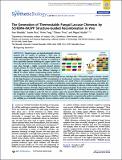Por favor, use este identificador para citar o enlazar a este item:
http://hdl.handle.net/10261/178891COMPARTIR / EXPORTAR:
 SHARE SHARE
 CORE
BASE CORE
BASE
|
|
| Visualizar otros formatos: MARC | Dublin Core | RDF | ORE | MODS | METS | DIDL | DATACITE | |

| Campo DC | Valor | Lengua/Idioma |
|---|---|---|
| dc.contributor.author | Mateljak, Ivan | es_ES |
| dc.contributor.author | Rice, Austin | es_ES |
| dc.contributor.author | Tron, Thierry | es_ES |
| dc.contributor.author | Alcalde Galeote, Miguel | es_ES |
| dc.date.accessioned | 2019-03-29T12:56:48Z | - |
| dc.date.available | 2019-03-29T12:56:48Z | - |
| dc.date.issued | 2019-03-21 | - |
| dc.identifier.citation | ACS Synthetic Biology 8(4): 833-843 (2019) | es_ES |
| dc.identifier.uri | http://hdl.handle.net/10261/178891 | - |
| dc.description.abstract | Fungal laccases are biotechnologically relevant enzymes that are capable of oxidizing a wide array of compounds, using oxygen from the air and releasing water as the only by product. The laccase structure is comprised of three cupredoxin domains sheltering two copper centers -the T1Cu site and the T2/T3 trinuclear Cu cluster- connected to each other through a highly conserved internal electron transfer pathway. As such, the generation of laccase chimeras with high sequence diversity from different orthologs is difficult to achieve without compromising protein functionality. Here, we have obtained a diverse family of functional chimeras showing increased thermostability from three fungal laccase orthologs with 70 % protein sequence identity. Assisted by the high frequency of homologous DNA recombination in Saccharomyces cerevisiae, computationally selected SCHEMA-RASSP blocks were spliced and cloned in a one-pot transformation. As a result of this in vivo assembly, an enriched library of laccase chimeras was rapidly generated, with multiple recombination events simultaneously occurring between and within the SCHEMA blocks. The resulting library was screened at high temperature identifying a collection of thermostable chimeras with considerable sequence diversity which varied from their closest parent homolog by 46 amino acids on average. The most thermostable variant increased its half-life of thermal inactivation at 70°C 5-fold (up to 108 min), whereas several chimeras also displayed improved stability at acidic pH. The two catalytic copper sites spanned different SCHEMA blocks, shedding light on the recognition of specific residues involved in substrate oxidation. In summary, this case-study through comparison with previous laccase engineering studies, highlights the benefits of bringing together computationally-guided recombination and in vivo shuffling as an invaluable strategy for laccase evolution, which can be translated to other enzyme systems. | es_ES |
| dc.description.sponsorship | This work was funded by the European Union [(Bioenergy-FP7-PEOPLE-2013-ITN-607793], the CSIC [project PIE-201580E042], and the Spanish Ministry of Economy, Industry and Competitiveness [projects BIO2013-43407-R.DEWRY and BIO2016-79106-R. LIGNOLUTION]. | es_ES |
| dc.description.sponsorship | We acknowledge support by the CSIC Open Access Publication Initiative through its Unit of Information Resources for Research (URICI). | - |
| dc.language.iso | eng | es_ES |
| dc.publisher | American Chemical Society | es_ES |
| dc.relation | info:eu-repo/grantAgreement/EC/FP7/607793 | es_ES |
| dc.relation | info:eu-repo/grantAgreement/MINECO/Plan Estatal de Investigación Científica y Técnica y de Innovación 2013-2016/BIO2013-43407-R | es_ES |
| dc.relation | info:eu-repo/grantAgreement/MINECO/Plan Estatal de Investigación Científica y Técnica y de Innovación 2013-2016/BIO2016-79106-R | es_ES |
| dc.relation.isversionof | Publisher's version | es_ES |
| dc.rights | openAccess | en_EN |
| dc.title | The generation of thermostable fungal laccase chimeras by SCHEMA-RASPP structure-guided recombination in vivo | es_ES |
| dc.type | artículo | es_ES |
| dc.identifier.doi | 10.1021/acssynbio.8b00509 | - |
| dc.description.peerreviewed | Peer reviewed | es_ES |
| dc.relation.publisherversion | https://doi.org/10.1021/acssynbio.8b00509 | es_ES |
| dc.identifier.e-issn | 2161-5063 | - |
| dc.embargo.terms | 2020-03-01 | es_ES |
| dc.rights.license | https://pubs.acs.org/page/policy/authorchoice_termsofuse.html | - |
| dc.contributor.funder | European Commission | es_ES |
| dc.contributor.funder | Consejo Superior de Investigaciones Científicas (España) | es_ES |
| dc.contributor.funder | Ministerio de Economía y Competitividad (España) | es_ES |
| dc.relation.csic | Sí | es_ES |
| oprm.item.hasRevision | no ko 0 false | * |
| dc.identifier.funder | http://dx.doi.org/10.13039/501100000780 | es_ES |
| dc.identifier.funder | http://dx.doi.org/10.13039/501100003339 | es_ES |
| dc.identifier.funder | http://dx.doi.org/10.13039/501100003329 | es_ES |
| dc.contributor.orcid | Alcalde Galeote, Miguel [0000-0001-6780-7616] | - |
| dc.type.coar | http://purl.org/coar/resource_type/c_6501 | es_ES |
| item.openairetype | artículo | - |
| item.languageiso639-1 | en | - |
| item.cerifentitytype | Publications | - |
| item.grantfulltext | open | - |
| item.fulltext | With Fulltext | - |
| item.openairecristype | http://purl.org/coar/resource_type/c_18cf | - |
| Aparece en las colecciones: | (ICP) Artículos | |
Ficheros en este ítem:
| Fichero | Descripción | Tamaño | Formato | |
|---|---|---|---|---|
| Generation_of_Thermostable_Fungal.pdf | Publisher’s version | 2,56 MB | Adobe PDF |  Visualizar/Abrir |
CORE Recommender
SCOPUSTM
Citations
31
checked on 15-may-2024
WEB OF SCIENCETM
Citations
24
checked on 25-feb-2024
Page view(s)
363
checked on 23-may-2024
Download(s)
145
checked on 23-may-2024
Google ScholarTM
Check
Altmetric
Altmetric
NOTA: Los ítems de Digital.CSIC están protegidos por copyright, con todos los derechos reservados, a menos que se indique lo contrario.
